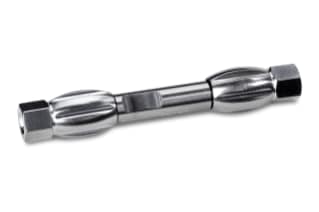This application note demonstrates RP-HPLC method for quality control of synthetic oligonucleotides using XTerra MS C18 Columns.
Although state-of-the-ort oligonucleotide synthesis is a fast and reliable process, the yield of the target product is limited. The full-length oligonucleotide (N) is typically contaminated with shorter failure products called N-1, N-2, N-3… Oligonucleotide purity decreases with the complexity of synthesis. The typical purity of crude 25mer product is ~75% while the purity of a 60mer product is ~20%. Occasionally the synthesis or post synthesis deprotection result in a product of inferior purity, which may compromise quality of the polymerase chain reaction (PCR) or other molecular biology assays.
Dissolve 5.6 mm glacial acetic acid in ~950 mL of water. While mixing add 13.86 mL of TEA. Adjust pH with diluted acetic acid to ~7 and adjust volume to 1L with water.
Dissolve 42.1 mL of HFIP in ~950 mL of water. While mixing vigorously add 2.28 mL of TEA. Adjust volume to 1L with water. The pH of solution should be close to 7.9.
XTerra MS C18 Columns are packed with porous 2.5 μm, hybrid particles. The sorbent has extended stability at temperatures and pH’s typically used for oligonucleotide separations (50–60 °C; pH 7–9). The column yields high resolution efficiency required for successful analysis of oligonucleotides (Figure 2). Volatile ion-pairing mobile phases are utilized to separate oligonucleotides according to their length. The resolution performance rivals that seen with capillary gel electrophoresis (Figure 1). With XTerra MS C18 Columns, baseline resolution of N from N-1 oligonucleotides is typically achieved for <30mer. Good resolution can be achieved for larger oligonucleotides (e.g. 60mer or larger: see (Figures 2 & 3)).
Triethylammonium acetate (TEAA) is an inexpensive volatile ion-pairing agent used for routine oligonucleotide analysis (Figure 2) and purification. Alternatively, triethylammonium-hexafluoroisopropanol buffer (TEA-HFIP) can be used for more efficient separation of long oligonucleotides (>45mer, Figure 3), and for applications using mass spectrometry detection.

WA20770, June 2003